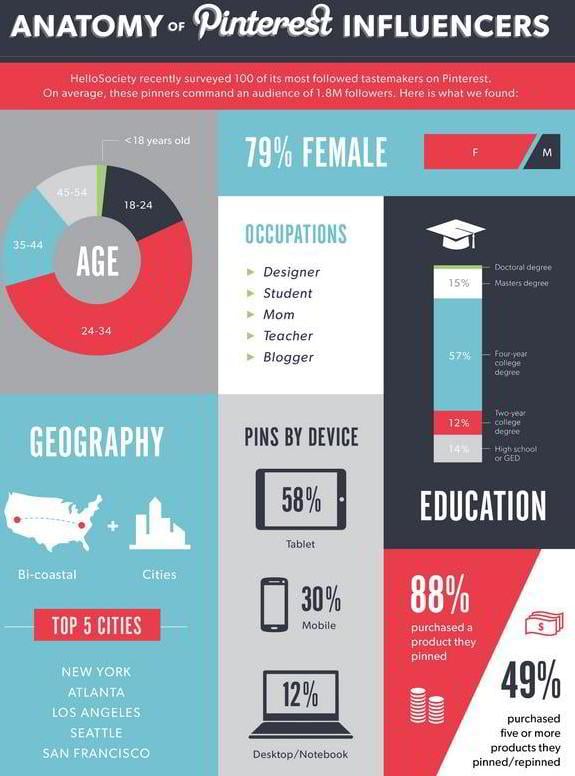How Pinterest Can Benefit B2B and B2C Brands?
Every social network has something unique to it. Facebook is unique for its “Like” button, Twitter’s uniqueness is 140-character long blogs and LinkedIn is unique for being the first professional criss-cross. Pinterest is an online pinboard; a visual catalog where images can be virtually pinned. The channel is the product of a creative idea, but inside its creative shell there’s a sloshy kernel that brands can devour. By the way do not hesitate to check our Free eBook The Art of Growing Your Presence on Pinterest
Pinterest for brand benefit
Pinterest serves business interests. It’s a hub for infographics. Brands can create account, set up pinboards and pin infographics. Apart from infographics, they can also put product images. Pinterest has proven to be a productive network for brands as it validates the aphorism that a picture is worth a thousand words.
Check out a set of ppt presentation templates to share your web design.
Using Pinterest, brands can also form a warm and jovial relationship with their audiences, the kind of relationship that e-commerce and social commerce brands aim to form. Visual communication has found to be more effective than non-visual communication. Project management life-cycles can be shared on Pinterest. So can be webinar marketing (a latest fad) visuals.
B2B or B2C?
Is Pinterest equally useful for both B2B and B2C? Not really.
Pinterest is skewed towards the B2C side. It is more useful for B2C brands than their B2B counterparts?
Why this bias? To answer this, we need to consider marketing insights obtained from how users all around the word use Pinterest.
Key insights
Almost 80% of Pinterest users are female. The majority of users access Pinterest from handheld devices like Smartphones and Tablets, millennials make up the biggest chunk of the user-base, moms login to Pinterest and more than 80% purchase products that they pin.
See below a graphic representation of these pivotal insights:
Once we analyze these insights, we can observe some clear patterns -
- Pinterest is rapidly growing
- Pinterest users are highly receptive to brands
- They make up a vibrant online community.
Such patterns are found in B2C communities. Hence yes, Pinterest is tilted to the B2C direction. Nevertheless, Pinterest is not sacrosanct for B2B marketers.
Pinterest for B2B
Some believe marketing around Pinterest is a sheer waste money and time for B2B brands. They highlight the fact that Pinterest doesn’t have an audience for B2B brands. More so, Pinterest lets users buy pins straight from inside the network but that’s not how B2B transactions take place.
While these are largely true, completely ignoring a network doesn’t make sense, especially when Pinterest does offer some opportunities for B2Bs. Brands can seize those opportunities if they segregate the visual aspects of their campaigns from other aspects. Two such aspects (Infographics and webinars) have already been acknowledged. Other aspects include pictures of happy customers and employees, slides, PPT presentations, case studies and marketing collaterals.
Let’s find out how Pinterest can facilitate each of these B2B aspects:
- Images of customers and employees: B2B brands can cash out on personalized engagement, similar to B2C brands - latest studies indicate. Instead of lackluster narratives of its workforce and clientele, a B2B brand can offer a visual experience of the same and potential clients may buy that.
- Slides and presentations: Slideshare is the default network for sharing slides. But in my opinion, Pinterest is an even better platform. Why? Because the onlooker won’t have to back and forth, he could see everything on a pinboard at once. The same applies to .ppt presentations.
- Case studies: Pinterest lets you spice up an otherwise boring B2B case study. Being a brand, you can create a board solely to feature case studies. The name and description fields are important. Add the phrase “Case Study” to both fields. Use hashtag to get a better visibility. This will make it easier for other businesses to locate your board.
- Marketing collaterals: B2Bs use collaterals during or before a product launch. Since collaterals are media elements, Pinterest is an ideal place to share them. Apart from images, screenshots of promotional videos can also be shared. Don’t add links to your site or product, add links to the video. If the screenshots are entertaining, users will click on those links to watch videos.
Pinterest is not a leverage for B2Bs per se, but the channel can aid them in highlighting some of the aspects related to branding. All these aspects have enough scope for visual elements.
Pinterest for B2C
For B2C brands, Pinterest is a goldmine. It’s their loss if they are not excavating it. Let’s refer again to the insights mentioned above and see what they indicate:
- Female user majority: Numerous studies indicate women are more receptive to buy branded products than men. In fact, the differences are not always on the quantitative level. Women don’t simply love to shop more than men, they also enjoy a pleasure from buying. As Pinterest is frequented by women (80%), fashion and accessory brands, perfume brands, home decoration and kitchen utensil manufacturing brands, all of whom are B2C, have overwhelmingly high chances of getting their products sold and creating a loyal customer-base, women are more loyal to brands than men.
- Moms on Pinterest: Pinterest is a hugely popular network among moms, so much so that it is reportedly driving them crazy. This insight comes in useful for baby product makers, who operate in the B2C niche. They can reach out to moms to advertise their products and drive up their sales this way.
- Handheld access: Handheld users are more prone to buying than desktop users. The buyable pins signify opt-in buying opportunity. In-app payment is easier for handheld users. Besides these, they have access to payment gateway apps. In short, B2Cs can replicate the retail buying experience on handheld devices thanks to Pinterest.
- Growing number of millennials: Millennials make up the majority of online shoppers. Observing the shopping habits of millennials, B2C brands can showcase products on Pinterest that are popular among them. Millennials also use handheld devices more than any other demographic groups.
Hence, all the insights that were previously cited clear the way for B2C brands. Of course, there are many variations within the fold of B2C and Pinterest is not equally useful for all these. For example, telcos and consumer product brands have a better prospect on Pinterest than other B2C brands.
Conclusion
As we’ve discussed in this article, Pinterest can be worthwhile for both B2B and B2C brands, depending on the level of sophistication of Pinterest marketing stratagem. If a brand considers Pinterest insights that are critical to strategy making and resort to strategic use of the network, then success will be the outcome.
How Do I Build An Audience On Social Media? [Free eBook]
Get more to your email
Subscribe to our newsletter and access exclusive content and offers available only to MonsterPost subscribers.



Leave a Reply
You must be logged in to post a comment.